Having suffered from acne all over his face, spreading down to his neck for many years without improvement, Mr. Hung bought corticosteroid creams to apply himself, causing his facial skin to become rough, swollen, and abnormally inflamed.
Mr. Hung (28 years old, from Binh Dinh province) visited Tam Anh General Hospital in Ho Chi Minh City on the morning of April 6th due to a mix of pustules and blackheads. The affected skin area was inflamed, bumpy, swollen, and spreading from his forehead, corners of his eyes, cheeks, and down to his neck. He said he had applied acne cream but it didn't help, so he recently bought corticosteroid medication, but his skin became even more swollen, and his face subsequently darkened and scarred.
Dr. Dang Thi Ngoc Bich, a dermatologist specializing in cosmetic skin care, used an LED light to examine the skin and found it to be oily, inflamed, scaly, with inflamed and clogged pores. The patient then underwent a skin analysis using a high-resolution camera to assess the condition of acne in the T-zone and U-zone.
In 5 minutes, the skin scanner outlines the patient's facial features using 3D images, detailing the condition of pores, wrinkles, moisture, elasticity, acne type, and analyzing the deeper layers of the skin. The results showed that Mr. Hung looked more than 2 years older than his actual age, his pores were larger than normal, with an average size of about 0.43 mm, and the U-shaped area had excessive oil due to overactive sebaceous glands.
On the other hand, test results showed that the patient's facial skin was infected with Propionibacterium acnes bacteria, leading to numerous pustules and pitted scars. The inflamed areas, resulting from the self-application of corticosteroids, further blocked the sebaceous gland ducts, causing the acne to swell.
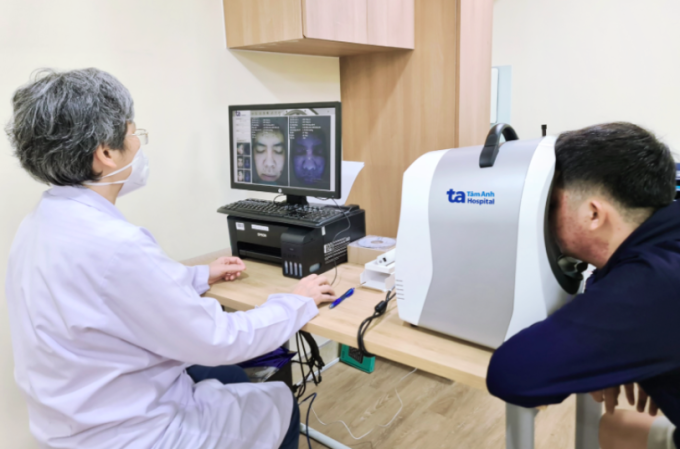
Doctor Bich is examining Mr. Hung's skin using a skin analyzer with a high-resolution camera. Photo: Dinh Tien
The patient was prescribed antibiotic ointment to reduce swelling and inflammation, and corticosteroid medication was discontinued. The doctor instructed Mr. Hung on proper acne skin care. After the acne cleared, the patient underwent another skin examination to determine a suitable treatment plan for acne scars and dark spots.
After more than two months of acne treatment, Mr. Hung's face was no longer inflamed, swollen, or painful. On the morning of June 6th, he had a follow-up appointment and received treatment for hidden acne. Dr. Bich stated that patients must undergo at least 10-12 weeks of treatment with oral medication, topical creams, and facial skincare products (cleanser, toner, etc.). After the acne clears, patients will receive treatment to reduce dark spots and fade scars using methods such as laser, electrophoresis, microneedling, and HA injections.
According to Dr. Dang Thi Ngoc Bich, over 80% of the world's population suffers from acne (redness, blackheads, whiteheads, cystic acne, pustules, and pustules), mostly under 30 years old. Many factors contribute to acne, including: family history, hormonal changes (puberty, menstruation, pregnancy), use of cosmetics and medications containing corticosteroids; a diet high in sugar and fat, smoking, and certain conditions affecting sebum secretion such as seborrheic dermatitis and folliculitis.
Approximately 20-30% of patients require medical treatment. Currently, there are many supportive and combined methods for treating acne, ranging from topical and oral medications to laser, IPL, electrophoresis, and microneedling. To select the appropriate acne treatment method, a skin analysis (dermatoscopy) is necessary so that the doctor can assess the overall condition of the lesions and develop a treatment plan tailored to each patient. During treatment, patients should not self-medicate, apply face masks, or use products with unknown ingredients, especially those containing corticosteroids, which can cause skin atrophy, dilated blood vessels, facial swelling, roughness, increased acne breakouts, and keloid or pitted scars.
Treatment with corticosteroids requires close monitoring by a doctor. Initially, topical corticosteroids may smooth the skin and reduce acne, but overuse can lead to thinning skin, suppressed immunity, severe acne breakouts, infection, and itching after a few months. If the patient scratches, the skin will become inflamed, swollen, and suppurating again.
Long-term abuse of corticosteroids leads to drug dependence (addiction) and numerous side effects such as: acne, pustules, inflammatory acne, osteoporosis, adrenal insufficiency, peptic ulcers, etc.
To reduce acne, patients should wash their face with clean water 2-3 times daily, but without scrubbing vigorously. For oily skin, patients can use an oil-controlling facial cleanser as prescribed by their doctor. Additionally, patients should avoid touching their face and refrain from squeezing pimples, especially in the T-zone near the maxillofacial and cranial sinuses. Infection in this area can cause facial swelling and cavernous sinusitis; in more severe cases, the inflammation can spread into the skull and cause meningitis.
It's important to limit your intake of sugary and fatty foods, alcoholic beverages, and caffeine. Instead, increase physical activity, eat plenty of green vegetables and fiber-rich foods, consume fruits high in antioxidants, and drink 1.5-2 liters of water daily.
Dinh Tien
Source link


![[Photo] Prime Minister Pham Minh Chinh receives Lao Minister of Education and Sports Thongsalith Mangnormek](/_next/image?url=https%3A%2F%2Fvphoto.vietnam.vn%2Fthumb%2F1200x675%2Fvietnam%2Fresource%2FIMAGE%2F2025%2F12%2F16%2F1765876834721_dsc-7519-jpg.webp&w=3840&q=75)
![[Photo] Prime Minister Pham Minh Chinh receives the Governor of Tochigi Province (Japan)](/_next/image?url=https%3A%2F%2Fvphoto.vietnam.vn%2Fthumb%2F1200x675%2Fvietnam%2Fresource%2FIMAGE%2F2025%2F12%2F16%2F1765892133176_dsc-8082-6425-jpg.webp&w=3840&q=75)
![[Live] 2025 Community Action Awards Gala](/_next/image?url=https%3A%2F%2Fvphoto.vietnam.vn%2Fthumb%2F1200x675%2Fvietnam%2Fresource%2FIMAGE%2F2025%2F12%2F16%2F1765899631650_ndo_tr_z7334013144784-9f9fe10a6d63584c85aff40f2957c250-jpg.webp&w=3840&q=75)


![[Image] Leaked images ahead of the 2025 Community Action Awards gala.](/_next/image?url=https%3A%2F%2Fvphoto.vietnam.vn%2Fthumb%2F1200x675%2Fvietnam%2Fresource%2FIMAGE%2F2025%2F12%2F16%2F1765882828720_ndo_br_thiet-ke-chua-co-ten-45-png.webp&w=3840&q=75)
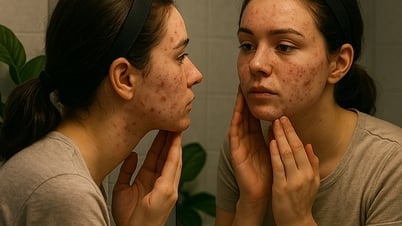

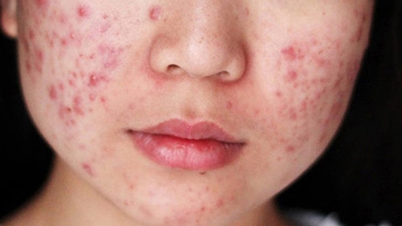

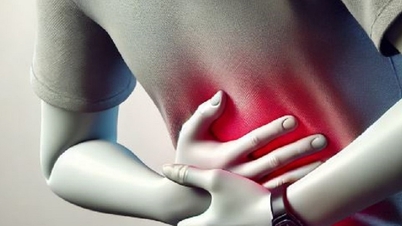













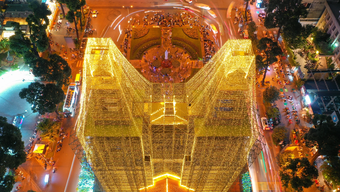
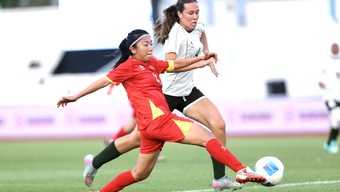















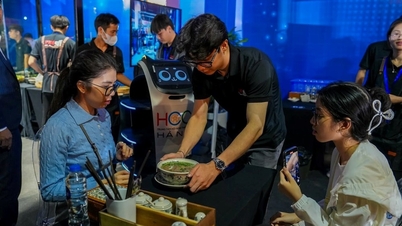


























![[Video] Independence and self-reliance linked with international integration through 40 years of reform](https://vphoto.vietnam.vn/thumb/402x226/vietnam/resource/IMAGE/2025/12/16/1765899635777_1-1-8054-png.webp)



































Comment (0)